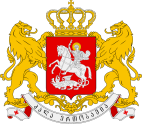Samtskhe-Saatabago
Samtskhe-Saatabago სამცხე-საათაბაგო | |||||||||
|---|---|---|---|---|---|---|---|---|---|
| 1266–1625 | |||||||||
 principiality of Samtskhe-Saatabago in XV century | |||||||||
| Capital | Akhaltsikhe | ||||||||
| Common languages | Georgian | ||||||||
| Religion | Eastern Orthodox Christianity | ||||||||
| Government | Principality | ||||||||
| Prince of Meskheti | |||||||||
• 1260-1285 | Sargis I (first) | ||||||||
• 1607–1628 | Manuchar III (last) | ||||||||
| Historical era | Late Middle Ages | ||||||||
• Established | 1266 | ||||||||
• Vassal of Mongol Empire | 1266-1334 | ||||||||
• Reunited with Kingdom of Georgia | 1334-1535 | ||||||||
• annexed by Ottoman Empire | 1555 | ||||||||
• Disestablished | 1625 1625 | ||||||||
| |||||||||
| Today part of | Countries today
| ||||||||
| Part of a series on the |
| History of Georgia |
|---|
 |
The Principality of Meskheti (Georgian: მესხეთის სამთავრო) or Principality of Samtskhe (Georgian: სამცხეს სამთავრო) was a Georgian feudal principality existing between 1268 and 1628. Its territory consisted of modern Meskheti and the historical region of Tao-Klarjeti.
History
Samtskhe-Saatabago was established after the expansion of the dukedom of Samtskhe. Dukes of Samstkhe were always distinguished by their longing for higher autonomy from the king of Georgia. After the Mongol invasion and their conquest of Georgia, Sargis I Jaqeli and David VII of Georgia rebelled against their Mongol overlords, but failed, and after a myriad of events Samtskhe-Saatabago was designated as a Khasinju, a territorial unit submitting only to the Khan, nominally being a Ulus. Samtskhe-Saatabago managed to remain a culturally developed part of Georgia as well as maintaining territorial integrity, sometimes even expanding along its borders. Samtskhe-Saatabago, which was fully independent at a time, was again incorporated in the Georgian Kingdom by George V of Georgia, who claimed maternal descent from the House of Jaqeli. George V made Samtskhe-Saatabago an integral part of Georgia once again. At the end of the 14th century, Timur's forces invaded Samtskhe-Saatabago several times. After the weakening of Georgian monarchy, the rulers of Samtskhe turned to separatism once more.
When Qvarqvare II's son Kaikhosro I died two years after he ascended the throne, and was succeeded by his equally pious brother Mzechabuk, the Iranian Safavids, led by the emerging Shah Ismail I were tempted to loot the feudal state, if only to distract himself from his main quarry; Shirvan.[1] In 1500, Shah Ismail inveigled the atabeg of Samtskhe, king Constantine II and king Alexander II of Imereti to attack Ottoman possessions nearby Tabriz.[2] As a precaution, Ismail had Aleksander send his son Demetre to the newly conquered region of Shirvan, where the prince negotiated a peace agreement. Ismail promised Constantine, once Tabriz was captured, to cancel the tribute he still paid the Ak Koyunlu Turcomans. Each Georgian ruler contributed 3,000 men to the existing Ismail's own 7,000.[3] By 1503 they enabled him to recapture Nakhchivan from the Ottomans, but Ismail broke his promise, and made Kartli and Kakheti his vassals.[4]
Princes of Meskheti
- Sargis I 1268–1279
- Beka I 1285–1306
- Sargis II 1306–1334
- Qvarqvare I 1334–1361
- Shalva 1372–1389
- Aghbugha I 1389–1395
- Ivane II 1391–1444
- Aghbugha II 1444–1451
- Qvarqvare II 1451–1498
- Kaikhosro I 1498–1500
- Mzetchabuki 1500–1515
- Manuchar I 1515–1518
- Qvarqvare III 1518–1535
- Kaikhosro II 1545–1573
- Qvarqvare IV 1573–1581
- Manuchar II 1581–1607
- Manuchar III 1607–1628
References
- ^ "Edge of Empires: A History of Georgia". Retrieved 15 December 2014.
- ^ "Edge of Empires: A History of Georgia". Retrieved 15 December 2014.
- ^ "Edge of Empires: A History of Georgia". Retrieved 15 December 2014.
- ^ "Edge of Empires: A History of Georgia". Retrieved 15 December 2014.
- Georgian Soviet encyclopedia, vol. 9, pg. 48-49, Tb., 1985




